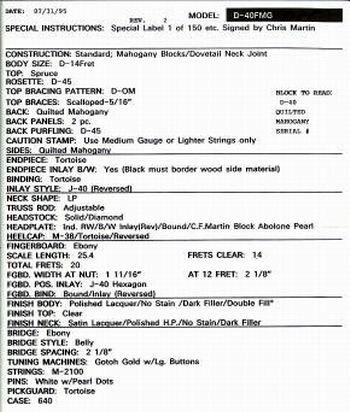Reader asks about the rare D-40FMG
A Lost Martin Model
Although I’ve been happy my 1975 D-18 for a long time, the Martin I now want is a 1995 D-40 FMG. I’ve been trying to figure out what FMG stands for, since it’s not a standard designation, and all I can come up with is Figured Mahogany – the wood used for its back and sides. I’d never even heard of a style 40; do you have any clues about a D-40 FMG? I appreciate anything you can tell me. Thanks!
– Dave P.
Spoon Replies:
Ah the D-40FMG, I understand the allure. They have figured mahogany back and sides, with the cosmetics of a D-40, only with tortoise rather than white binding on the body, neck and headstock.
I would love to own one myself. Being a bit of a rare bird, I see modern pricing listed from just over $3K to just under $5K; the latter seems like wishful thinking to me for a mahogany/Sitka dreadnought from 1995.
Still, I think they look gorgeous with the tortoise binding on the neck, and it is unusual to get a mahogany Martin with so much abalone inlay.
The “FM” would have stood for Figured Mahogany, but the examples I have seen have figuring that could be called “quilted” or “ribboned” or even “waterfall.” It is a naturally occurring feature in quartersawn mahogany. But it is relatively rare compared to figuring seen in flatsawn wood.
I never could find out what the G stood for. So asked Michael Dickinson, wood buyer for Martin. He said that at the time MG stood for Mahogany, rather than just M, or FM which could be Figured Maple. I assume it might also be related to the fact M at that time had just started being used to refer to the M top size, as in the new J-40M that had recently come on the market.
This model was part of the Figured Wood Edition series, which included the D-40FMG, made in 1995 (two were made in 1996,) and a D-40FW (figured walnut, 148 made,) and the D-40QM (quilted maple, 164 made,) both were built in 1996.
In the 1980s they also had similar series of dreadnoughts made in Style 16 that had Mahogany, Ash, Walnut, and Koa for the back and sides.
Otherwise, The D-40FGM has the styling similar to the D-40, but came out two years before the Standard D-40 was released in 1997.
The D-40BLE appeared in 1990, as a Guitar of the Month (which did not come out anything like monthly.) It was designed by Mike Longworth, and was based on Style 40 from the 1930s, with snowflake fret markers and other features that make it unrelated to the Figured Wood Edition D-40 models.
Most interesting to me is the fact the D-40FMG seems to be a forgotten model. By this I mean, it was left out entirely from Martin Guitars: A Technical Reference, wherein Richard Johnston and Dick Boak edited and greatly expanded Longworth’s original history of Martin Guitars.
Modern Style 40 gets a meager one sentence, about the J-40, and while it mentions the D-40 in the notes beneath, none of these LE D-40 models are listed among the other Limited and Special Editions.
The production totals for all D-40 models do appear in the appendix, but they are buried in an obscure table, and not listed between the D-37 and D-41, as one might expect.
Here is a spec sheet for the D-40FMG
Style 40 has been around since the 1850s, when it was made in Size 2 for $40. It was $84 in the first printed price lists of the 1870s. It did not appear in sizes 0-000 until after 1900, and up until it was retired in 1941 it was basically Style 42 with slightly less pearl trim.
Modern Style 40 (with the small hexagon fret markers and black and white ply purfling) debuted on Martin’s J-40M (M stood for the M body silhouette, not for mahogany.) It was Martin’s first jumbo model and Chris Martin’s first major contribution to the Martin line.
The D-40 followed in 1997. In terms of construction and wood quality, it is an HD-28, but has the cosmetic features of a D-41 – except it has unique reversed black and white ply trim around the edge of the top rather than abalone shell.
The D-40 remained in the catalog until quite recently, but it was not nearly as common as the J-40, which was offered in the normal Style 40 and in an all-black version.
